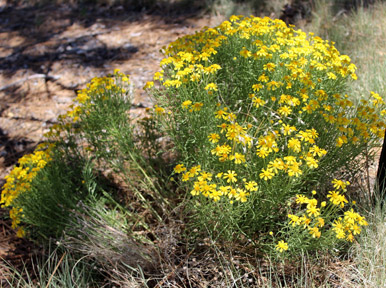Description
"Senecio flaccidus, formerly recorded as Senecio douglasii (in honor of the botanist David Douglas) member of the daisy familyand genus Senecio also known as threadleaf ragwort[3] (and threadleaf groundsel, bush senecio, creek senecio, shrubby butterweed, comb butterweed, smooth threadleaf ragwort, Mono ragwort, Douglas ragwort, Douglas groundsel, sand wash groundsel, felty groundsel, old man, yerba cana, squawweed or cenicillo) is a native of the southwestern Great Plains of North America.[4][5][6][7]
Threadleaf ragwort is a fast-growing, short-lived (3 to 6 years) bushy perennial shrub growing to 4 feet 6 inches (1.37 m); common in gravelly washes, dry creek beds, along roads and trails and mostly away from the coast.[5]
- Leaves and Stems
- Branched and bushy, Senecio flaccidus gets its common name from its white, threadlike, bent and matted, tomentose leaves; alternate and deeply pinnated, divided into five to nine narrow linear segments, glabrous, having no hairs or projections, gray-green above, 1 inch (2.5 cm) to 4 inches (10 cm) long. The principal leaves often have auxiliary clusters of smaller leaves.[5]The stems are grooved and the branches are thin, herbaceous above and woody near the base.[4][5]
- Flowers
- Showy flowering heads of yellow ray flowers, 3 inches (7.6 cm) - 4 inches (10 cm) across; eight to thirteen sterile rays, purplish brown disk florets that produce the seeds.[5][6]
- Seeds
- Dicotyledon fruits; each a 1/8 inch (3 mm) long achene ribbed and hoary, covered with short white hairs.[4][5][6]" (Wikipedia)
Ethnobotanical Uses
Medicine:
"Some groundsels (e.g. common groundsel, western groundsel) contain pyrrolizidine alkaloids that cause irreversible liver damage after long-term exposure and may cause liver cancer. Alkaloid concentrations are highest in the flowers and lowest in roots and young leaves but levels vary greatly from species to species and plant to plant. ---Some people use groundsel in teas and herbal remedies. Extended use of groundsel tea or use of flour contaminated with groundsel seed has caused loss of appetite, vomiting, bloody diarrhea, sleepness, weakness, staggering and jaundice with liver damage and even death. Some people develop rashes from contact with these plants." (Kershaw 252)
"Hopi Antirheumatic (External) Poultice of flowers and leaves used for sore muscles. Dermatological Aid Poultice of ground leaf used for pimples and skin diseases. --- Ground leaves applied to pimples. Orthopedic Aid Pounded plant smeared over sore muscles. --- Jemez Stimulant Plant placed on hot coals and smoke stimulated faint and sick person. Keres, Western Dermatological Aid Leaves used in shoes to prevent sweaty feet. Plant mixed with artemisia and deer marrow to make a salve. Gastrointestinal Aid Infusion of 6-inch piece of twig used for stomach trouble. --- Navajo, Kayenta Dermatological Aid Poultice of plant applied to boils. --- (Moerman 527)
Other Uses:
"Keres, Western Incense & Fragrance Plant parts used in bed for the good smell. Insecticide Plant parts used in bed as a bedbug repellent. ---" (Moerman 527)
